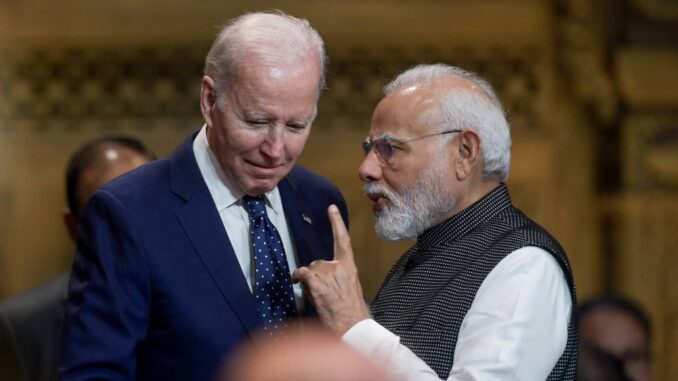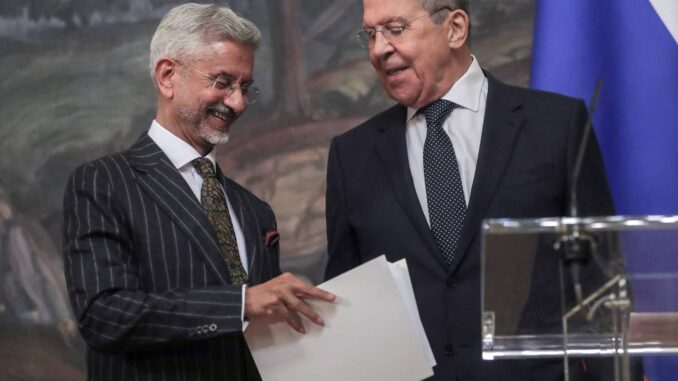by April 2023

US President Joe Biden talks with India’s Prime Minister Narendra Modi at the opening of the G20 Summit, November 15, 2022. Photo credit: BAY ISMOYO/Pool via REUTERS
India and the United States have overcome the distance and suspicions that arose out of India’s refusal to align itself with the US soon after its independence in 1947. Over the last three decades, the world’s oldest and largest democracies have built a multi-layered and likely enduring partnership.
Public opinion in both countries favors close relations. According to a 2022 Gallup poll, 77 percent of Americans have a favorable view of India. In a 2021 poll, 79 percent of Indians had a favorable image of the United States. There are few countries in the world where public opinion is so strongly supportive of the United States.
Under both Trump and Biden administrations, US national security strategy documents portray India as a key American partner not only in the Indo-Pacific but also in South and Southeast Asia. India is referred to in both strategy documents as a key partner with whom the US works both in bilateral and multilateral settings and a country that supports “our shared vision of a free and open Indo-Pacific.”
India is central to two of America’s strategic blocs – the Pacific Quad of Australia, India, Japan, and the US and the West Asia Quad launched in October 2021 and now referred to as I2U2 – comprising India, Israel, United Arab Emirates, and the United States.
The importance of the relationship can be seen also in the US Congress. A Senate amendment to the National Defense Authorization Act (NDAA) 2023, introduced by Senators Mark Warner, Jack Reed, and Jim Inhofe, echoed a similar House resolution, proposed by Congressman Ro Khanna. It noted that India faced military aggression from China and that the United States should support India’s defense needs and also help India “accelerate its transition away from weapons and defense systems manufactured in the Russian Federation.”
Strengthening Military and Technology Ties
India is a Major Defense Partner of the United States and the two countries are more aligned today in the military realm than ever before, as seen in bilateral and multilateral military exercises, liaison officer exchanges, and maritime security cooperation. Homeland security and counter terrorism cooperation between India and the US is only two decades old but the two now work together on screening of terrorists, dealing with cyber threats from terror groups, intelligence and information sharing, aviation security and capacity building.
In January 2023, the US and Indian national security advisors announced the launch of the US-India Initiative on Critical and Emerging Technologies (iCET). This strategic technology partnership arises from US concerns about China, which India seems to share. A Defense Innovation and Technology Cooperation sub-initiative launched in January 2023 seeks to build a new bilateral Defense Industrial Cooperation Roadmap that will “accelerate technological cooperation” in military technologies.
India wants to build indigenous telecommunications systems. The US appears prepared to share technology and support India’s long-standing desire for indigenization – for “made in India’ projects. The Biden administration’s announcement about providing funding for the Indian tech sector is meant to show how various initiatives could complement each other.
Lagging Trade and Investment Ties
The commercial and economic pillar of the partnership has yet to achieve its goal of $500 billion in annual two-way trade by 2020. The United States is India’s largest trading partner and bilateral trade in goods and services currently stands at around $152 billion. There are several strong points: India is the fourth largest international market for US crude oil and the fifth largest for US liquified natural gas; in healthcare, India supplies 60 per cent of the generic pharmaceutical requirements of the United States.
A major reason for lagging trade ties is that India’s economy has slowed down over the last decade and the country has shown a preference for protectionist policies. In May 2022, India joined the Indo-Pacific Economic Framework showing its support for the US Indo Pacific strategy, but has kept out of the trade pillar.
The Biden administration, as part of its October 2022 National Security Strategy, speaks of out-competing China by asking US companies to relocate their business operations to ‘friendly’ countries. During her November 2022 visit to India, Secretary Yellen stated that the Biden administration wants to help its friends and partners “diversify away from countries that present geopolitical and security risks to our supply chain.” This entails “proactively deepening economic integration with trusted trading partners like India. Our strategy will also create redundancies in our supply chain to mitigate over-concentration risks.”
Managing the Russia Problem
India’s refusal to stop buying Russian oil and military equipment, and its abstention on UN votes condemning Russia’s invasion of Ukraine, have irritated the bilateral relationship and have the potential to limit future cooperation.
In 2018, India signed a $5 billion deal with Russia for purchase of S-400 surface-to-air missile systems, which are currently due for delivery. India has argued that it does not make sense for the US to stop India from acquiring a critical weapons system that is needed for India’s security, especially since the US was slow to offer India a comparable missile system.

In June 2022 the US House of Representatives sought to pave the way for removing a potential irritant in India relations when it called upon the Biden administration to issue an India-specific waiver under the Countering America’s Adversaries Through Sanctions Act (CAATSA). Secretary of State Blinken can now exempt India from CAATSA sanctions designed to impose restrictions on countries that buy military systems from Russia.
The Ukraine crisis brought to the fore India’s dependence on Russian military equipment – a legacy of the Cold War era – and while differences remain, India and the US are seeking to work through these divergences. The United States would like India to purchase more American defense equipment. From a base of nearly zero US arms purchases, India has purchased over $20 billion in the last decade. The Indian Navy is the second-largest operator of P-8I Poseidon maritime patrol aircraft globally and the Indian Air Force operates the second-largest C-17 fleet in the world after the United States.
There remain important outstanding matters on the bilateral agenda for further dialogue, including US concerns with protection of minorities in India. However, the Biden administration has reaffirmed that America’s global interests, framed currently by peer competition with China, make India a critical American partner. India too has been happy to signal that, unlike during the Cold War when it rebuffed US overtures, it is now eager to partner with America.
Aparna Pande is the director of the Hudson Institute’s Initiative on the Future of India and South Asia. Her books include Making India Great: The Promise of a Reluctant Global Power (Harper Collins, 2020).



Leave a Reply
You must be logged in to post a comment.